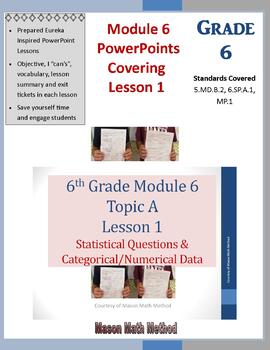6th Math Mod 6 Lesson 1 Statistical Questions & Categorical/Numerical Data Power
- Zip
Description
This download contains 6th grade math Module 6 Topic A Lessons 1-5 PowerPoint Lessons from the Engage NY Eureka Math program, and self-made using other various resources (Total 65 slides). Topic A Lesson 1 covers the following: Statistical questions and categorical/numerical data.
I created/put this PowerPoint lesson together to help me lead my lesson and make sure I covered all the things required such as objective, I “can” statements, vocabulary, lesson summary and exit ticket. Each lesson I pulled out what I felt I needed or could use in the time I had. Remember that all Eureka lessons can be found on their website for FREE…this product is my own lesson plan on how I taught the lessons.
Some items I have put in I ended up skipping due to time constraints but I always tried to make sure I had plenty to do so don’t be surprised if you have to skip a few examples/exercises to keep in your timeframe. Either way, these kept my lessons flowing, students engaged throughout, and I have all the answers included so you won’t have to solve anything.
I used these PowerPoint’s 4th quarter 2020 to deliver virtual classes to my students. All students needed to participate were paper and pencil. I do have additional handouts I made to go along with some of the lessons if you want to use them; but they are not required.
I have 8 years teaching experience (1 year teaching 9th-10th grade health, 6 years teaching 5th grade math, and this is my 1st year teaching 6th grade math). I have been a level 5 teacher for the past 6 years.
Below I have listed what you will be getting in this download.
Module 6 Lesson 1 and Teacher Toolbox Lesson 26 (1 Day Lesson Plan):
Title: Review Statistical Questions and Categorical/Numerical Data
- 65 total slides covering
- Objective
- I “can” statement
- Vocabulary
- Lesson 1
- Example 2
- Exercises 1a-1e
- Example 3
- Exercises 6a-6f
- Problem Set Q#1a-1g
- Problem Set Q#2a-2e
- TT Lesson 26 Examples 2a-2c
- Lesson Summary
- TT Lesson 26 Exit Ticket
- Answers to suggested Homework (See handout titled Mod 6 Lesson 1 Categorical/Numerical Homework student copy and answer key)
Attention Districts and Departments: If you are purchasing for your school’s department, please buy the appropriate amount of licenses. If you are a large school district and you are interested in a full district license, please contact me for a district-wide quote.
LICENSING TERMS: This purchase includes a license for one teacher only for personal use in their classroom. Licenses are non-transferable, meaning they cannot be passed from one teacher to another. No part of this resource is to be shared with colleagues or used by an entire grade level, school, or district without purchasing the proper number of licenses. If you are a coach, principal, or district interested in transferable license to accommodate yearly staff changes, please contact me for a quote.
COPYRIGHT TERMS: This resource may not be uploaded to the internet in any form, including classroom/personal websites or network drives, unless the site is password protected and can only be accessed by students. Violations are subject to the penalties of the Digital Millennium Copyright Act.





